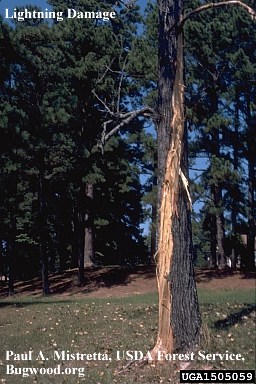 Description: Trees, because they are normally the tallest point around, are natural lightning rods. When a tree is struck by lightning the liquids inside the trunk turn to gas instantly, leading to an explosion of bark. About half of the trees struck by lightning will die instantly, the other half will live for a number of years, although often weakened and made susceptible for future disease. With 100 lightning strikes happening per second around the world, trees are more vulnerable than you think. Oaks and poplars tend to be taller and have a higher moisture content, which increases their chances of being struck by lightning. If a tree is struck after being soaked by rain it has a better chance of survival. The electrical shock is better able to move down the outside surface moisture instead of going through the interior of the tree. Beech and river birch are rarely struck. Oaks, pine, gum, poplars and maple are common targets. Some feel that the composition of the tree is the difference. Beech and birch are high in oils. Ash, pine and oak are high in starch, which is a good conductor.
Symptoms: The effect lightning strikes have on trees varies. Sometimes the tree splinters or shatters upon impact. Some trees are scarred by a strip of blown-away bark. Others seemingly have no damage at all, and then die a few weeks or months later, probably because the unseen damage was in the root zone. A tree struck by lightning has been severely stressed. To deal with this stress the tree needs additional nutrients. By supplying additional water to a lightning damaged tree, it will be able to take up more nutrients.
Stressed trees are also targets for insect and disease problems. Applying fertilizer will help stimulate growth of injured trees. If the tree survives long enough to leaf out the following spring, chances for recovery are good. Remove any broken branches and torn or splintered wood from the injured tree. Delay extensive repairs for 6 – 12 months so you can fully assess the damage that has been done.
Action: To prevent lightning damage to special trees a lightning protection system can be installed. A series of copper cables are attached to the trees highest branches and then grounded a safe distance from the tree. If lightning strikes the tree the current flows down the cables and safely to the ground. It is best to consult with your arborist before considering a protection system for a tree.
Thank you for reviewing this information. Schneider Tree Care is committed to preserving and enhancing the quality of your property through tree care education and services. We employ professionally trained and certified arborists who are available to meet with you for a consultation at no charge. If you have any questions or need additional information regarding the health of your trees, please contact us.
Description: Trees, because they are normally the tallest point around, are natural lightning rods. When a tree is struck by lightning the liquids inside the trunk turn to gas instantly, leading to an explosion of bark. About half of the trees struck by lightning will die instantly, the other half will live for a number of years, although often weakened and made susceptible for future disease. With 100 lightning strikes happening per second around the world, trees are more vulnerable than you think. Oaks and poplars tend to be taller and have a higher moisture content, which increases their chances of being struck by lightning. If a tree is struck after being soaked by rain it has a better chance of survival. The electrical shock is better able to move down the outside surface moisture instead of going through the interior of the tree. Beech and river birch are rarely struck. Oaks, pine, gum, poplars and maple are common targets. Some feel that the composition of the tree is the difference. Beech and birch are high in oils. Ash, pine and oak are high in starch, which is a good conductor.
Symptoms: The effect lightning strikes have on trees varies. Sometimes the tree splinters or shatters upon impact. Some trees are scarred by a strip of blown-away bark. Others seemingly have no damage at all, and then die a few weeks or months later, probably because the unseen damage was in the root zone. A tree struck by lightning has been severely stressed. To deal with this stress the tree needs additional nutrients. By supplying additional water to a lightning damaged tree, it will be able to take up more nutrients.
Stressed trees are also targets for insect and disease problems. Applying fertilizer will help stimulate growth of injured trees. If the tree survives long enough to leaf out the following spring, chances for recovery are good. Remove any broken branches and torn or splintered wood from the injured tree. Delay extensive repairs for 6 – 12 months so you can fully assess the damage that has been done.
Action: To prevent lightning damage to special trees a lightning protection system can be installed. A series of copper cables are attached to the trees highest branches and then grounded a safe distance from the tree. If lightning strikes the tree the current flows down the cables and safely to the ground. It is best to consult with your arborist before considering a protection system for a tree.
Thank you for reviewing this information. Schneider Tree Care is committed to preserving and enhancing the quality of your property through tree care education and services. We employ professionally trained and certified arborists who are available to meet with you for a consultation at no charge. If you have any questions or need additional information regarding the health of your trees, please contact us. 




